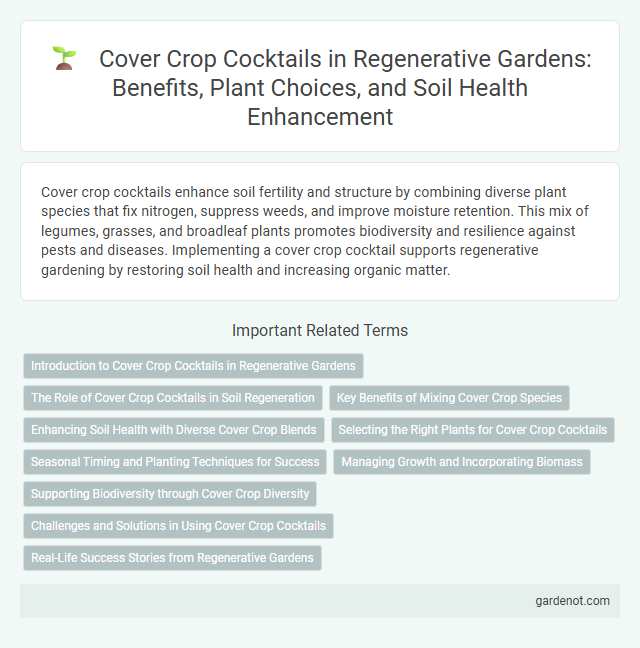Cover crop cocktails enhance soil fertility and structure by combining diverse plant species that fix nitrogen, suppress weeds, and improve moisture retention. This mix of legumes, grasses, and broadleaf plants promotes biodiversity and resilience against pests and diseases. Implementing a cover crop cocktail supports regenerative gardening by restoring soil health and increasing organic matter.
Introduction to Cover Crop Cocktails in Regenerative Gardens
Cover crop cocktails in regenerative gardens combine multiple plant species to enhance soil health, increase biodiversity, and improve nutrient cycling. These diverse mixtures protect the soil from erosion, suppress weeds, and promote beneficial microbial activity critical for sustainable agriculture. Incorporating legumes, grasses, and broadleaf plants ensures balanced nitrogen fixation, organic matter accumulation, and habitat diversity in regenerative farming systems.
The Role of Cover Crop Cocktails in Soil Regeneration
Cover crop cocktails play a crucial role in soil regeneration by enhancing soil structure, increasing nutrient availability, and promoting biodiversity within the soil ecosystem. These diverse plant mixtures improve organic matter content, reduce erosion, and support beneficial microbial activity, which collectively restore soil health and fertility. Implementing cover crop cocktails in regenerative gardens accelerates nutrient cycling and carbon sequestration, essential for sustainable land management.
Key Benefits of Mixing Cover Crop Species
Mixing cover crop species in a regenerative garden creates a diverse root network that enhances soil structure and nutrient cycling. This diversity suppresses weeds more effectively while promoting beneficial insect habitats and microbial activity. Combining legumes, grasses, and brassicas maximizes nitrogen fixation, organic matter input, and pest resistance, boosting overall ecosystem resilience.
Enhancing Soil Health with Diverse Cover Crop Blends
Cover crop cocktails enhance soil health by combining diverse plant species such as legumes, grasses, and brassicas to improve nutrient cycling, increase organic matter, and suppress weeds. These blends promote microbial diversity and soil structure, leading to better water retention and reduced erosion. Incorporating cover crop cocktails into regenerative garden practices supports sustainable fertility and long-term ecosystem resilience.
Selecting the Right Plants for Cover Crop Cocktails
Selecting the right plants for cover crop cocktails involves combining species with complementary functions such as nitrogen fixation, deep root penetration, and biomass production to enhance soil health and biodiversity. Including legumes like clover or vetch improves nitrogen levels, while grasses such as rye or oats provide soil structure and erosion control. The balance of warm- and cool-season crops ensures year-round ground cover and maximizes nutrient cycling in regenerative gardens.
Seasonal Timing and Planting Techniques for Success
Selecting the right cover crop cocktail for each season ensures optimal soil health and nutrient cycling in regenerative gardens. Planting techniques such as seed depth adjustment, proper spacing, and staggered planting align with seasonal conditions to maximize germination and biomass production. Timing cover crop sowing after main crop harvest or during early fall leverages cooler temperatures and soil moisture for successful establishment.
Managing Growth and Incorporating Biomass
Cover crop cocktails, composed of diverse species like legumes, grasses, and brassicas, optimize soil health by managing growth cycles and suppressing weeds. Timely mowing or rolling these crops maximizes biomass incorporation, enhancing soil organic matter and nutrient cycling. This strategic management supports improved soil structure and water retention in regenerative gardens.
Supporting Biodiversity through Cover Crop Diversity
Cover crop cocktails in regenerative gardens combine multiple plant species to enhance soil health and support biodiversity. Diverse cover crops create habitats for beneficial insects, promote microbial activity, and improve nutrient cycling within the ecosystem. This variety strengthens resilience against pests and diseases while enriching the soil structure and fertility.
Challenges and Solutions in Using Cover Crop Cocktails
Using cover crop cocktails presents challenges such as seed selection complexity, competition among species, and management timing. Solutions include tailored seed mixes based on soil tests, strategic planting schedules to optimize growth stages, and monitoring to balance species interactions for maximum soil health benefits. Proper management enhances nitrogen fixation, erosion control, and biodiversity in regenerative gardens.
Real-Life Success Stories from Regenerative Gardens
Cover crop cocktails, combining diverse species like clover, radishes, and peas, have significantly improved soil health and crop yields in regenerative gardens worldwide. In Vermont, a regenerative farm reported a 30% increase in organic matter and reduced erosion after integrating these multi-species cover crops into their planting cycles. Studies from California vineyards demonstrated enhanced nutrient cycling and water retention, showcasing cover crop cocktails as a pivotal strategy in sustainable agriculture practices.
Cover crop cocktail Infographic

 gardenot.com
gardenot.com